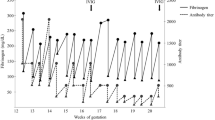Abstract
The pathogenesis of erythroblastosis fetalis in man seems to be well known and understood (Wiener and Wexler, 1950; Wiener, 1961). In the classic case, an Rh-negative pregnant woman becomes sensitized to the Rh factor, usually as a result of transplacental leakage of fetal Rh-positive blood into her circulation. The resulting maternal Rh antibodies readily pass through the placenta into the fetal circulation and then coat the red cells of the fetus, leading to their destruction and giving rise to manifestations of hemolytic disease. In the most severe cases, there is stillbirth or hydropic or macerated fetus with marked hepatosplenomegaly; less severely affected offspring are liveborn with pronounced jaundice (icterus gravis) which may lead to kernicterus, causing severe mental retardation. The mildest manifestation is hemolytic anemia. As can be expected, the severity of the manifestations is usually correlated with the degree of sensitization of the mother, i.e., the higher the titer of the maternal antibodies, the greater the stillbirth rate.
Access this chapter
Tax calculation will be finalised at checkout
Purchases are for personal use only
Preview
Unable to display preview. Download preview PDF.
Similar content being viewed by others
References
Erskin, A. G. and Socha, W. W.: The Principles and Practice of Blood Grouping, 2nd Edition, St. Louis: C. V. Mosby, 1978.
Gengozian, N., Lushbaugh, C. C., Humason, G. I., and Kniseley, R. M.: Erythroblastosis fetalis in the primate Tamarinus nigricollis. Nature, Lond. 209: 731–732, 1966.
Kellner, A. and Hedal, E. F.: Experimental erythroblastosis fetalis. Amer. J. Path. 28: 539–542, 1952.
Kellner, A. and Hedal, E. F.: Experimental erythroblastosis fetalis in rabbits. I. Characterization of a pair of allelic blood group factors and their specific immune isoantibodies. J. exp. Med. 97: 33–49, 1953.
Moor-Jankowski, J. and Wiener, A. S.: Red cell antigens in primates. Pp. 270–371 in: Pathology of Simian Primates, R. N. Fiennes (Ed.), Basel: S. Karger, 1972.
Roberts, G. F.: Comparative Aspects of Haemolytical Disease, London: Heinemann, 1957.
Socha, W. W., Moor-Jankowski, J., Wiener, A. S., Risser, D. R., and Plonski, H.: Blood groups of bonnet macaques (Macacaradiata) with a brief introduction to seroprimatology. Amer. J. phys. Anthrop. 45: 485–492, 1972.
Socha, W. W., Wiener, A. S., Moor-Jankowski, J., Scheffrahn, W., and Wolfson, S. K., Jr.: Spontaneously occurring agglutinins in primate sera. Int. Arch. Allergy Appl. Immunol. 51: 656–670, 1976.
Sullivan, P., Duggleby, C., Blystad, C., and Stone, W. H.: Transplacental isoimmunization in rhesus monkey. Fed. Proc. 31: 792, 1972.
Verbickij, M. S.: The use of hamadryas baboons for the study of the immunological aspects of human reproduction. Pp. 492–505 in: The Use of Nonhuman Primates in Research on Human Production, E. Diczfalusy and C. C. Standley Eds.), Stockholm: WHO Research and Training Centre on Human Reproduction, Karolinska Institutet, 1972.
Verbitsky, M., Volkova, L., Kuksova, M., Lapin, B., Andreyev, A., and Gvazava, I.: A study of haemolytic disease of the foetus and the newborn occurring in Hamadryas baboons under natural consitions. Z. Versuchstierk II: 136–145, 1969.
Volkova, L. S., Vyazov, O. E., Verbitsky, M. S., Lapin, B. A., Kuksova, M. I., and Andreyev, A. V.: Experimental reproduction of the hemolytic disease of the newborn in Papio hamadryas (linneus). Rev. roum. Embryol. Cytol. 3: 119–130, 1966.
Wiener, A. S.: Hr-Hr Blood Types, New York: Grime and Stratton, 1961.
Wiener, A. S., Socha, W. W., and Moor-Jankowski, J.: Erythroblastosis models. H. Materno-fetal incompatibility in chimpanzee. Folia prim at. 27: 68–74, 1977.
Wiener, A. S., Socha, W. W., Niemann, W., and Moor-Jankowski, J.: Erythroblastosis models. A review and new experimental data in monkeys. J. med. Primatol. 4: 179–187, 1975.
Wiener, A. S. and Wexler, I. B.: Erythroblastosis foetalis und Blutaustausch. Stuttgart: Georg Thieme, 1950.
Wiener, A. S. and Wexler, I. B.: Rh-Hr Syllabus, 2nd Ed., p. 51, New York: Grune and Stratton, 1963.
Author information
Authors and Affiliations
Editor information
Editors and Affiliations
Rights and permissions
Copyright information
© 1979 Plenum Press, New York
About this chapter
Cite this chapter
Socha, W.W., Moor-Jankowski, J. (1979). Serological Materno-Fetal Incompatibility in Nonhuman Primates. In: Ruppenthal, G.C., Reese, D.J. (eds) Nursery Care of Nonhuman Primates. Advances in Primatology. Springer, Boston, MA. https://doi.org/10.1007/978-1-4684-3477-4_4
Download citation
DOI: https://doi.org/10.1007/978-1-4684-3477-4_4
Publisher Name: Springer, Boston, MA
Print ISBN: 978-1-4684-3479-8
Online ISBN: 978-1-4684-3477-4
eBook Packages: Springer Book Archive




